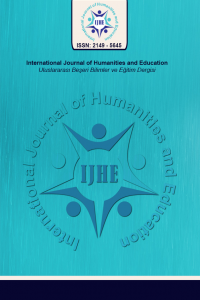Fate of Khorezmians who remained in Asia Minor after the death of Khorezmshah Jalal ad-Din Mingburnu
In the article, there has been studied the role and influence of Khorezmians, who went with Jalal ad-Din Mingburnu to Asia Minor after his death, in the political life of the region. The entry of the commanders and military units of the Khorezm state into the service of the Seljuk state in Asia Minor and the relations of the Seljuk rulers with the Khorezm emirs are analyzed. At the same time, there are reasons why most of the Khorezmian military units left the territory of Anatolia. This article is focused on why most of the Khorezmians left Anatolia and the strained relations with the Seljuk rulers Ala ad-Din Kayqubod and Giyosiddin Kaykhusrav. Ala ad-Din Kayqubod and other Roman Seljuk rulers express their views on why the Khorezmians were divided into central and eastern Anatolia and why they were later moved to the west. The article analyzes the views on the ethnic composition of the Khorezmians. A brief history of the Beyliks Sarukhan and Hermian, founded by the Khorezmians in Anatolia, is told. There is information about the villages and their location of the “Horzumlu” (Khorezmians) who lived in Anatolia from the 13th century to the present day. Several maps related to the Khorezmians left in Anatolia have been prepared for the article, and these maps are also provided.
Anahtar Kelimeler:
Horzumlu, Khorezm, Jalal ad-Din Mingburnu, Qangly, Kypchak/Qipchaq, Kair han, Germiyan
Fate of Khorezmians who remained in Asia Minor after the death of Khorezmshah Jalal ad-Din Mingburnu
In the article, there has been studied the role and influence of Khorezmians, who went with Jalal ad-Din Mingburnu to Asia Minor after his death, in the political life of the region. The entry of the commanders and military units of the Khorezm state into the service of the Seljuk state in Asia Minor and the relations of the Seljuk rulers with the Khorezm emirs are analyzed. At the same time, there are reasons why most of the Khorezmian military units left the territory of Anatolia. This article is focused on why most of the Khorezmians left Anatolia and the strained relations with the Seljuk rulers Ala ad-Din Kayqubod and Giyosiddin Kaykhusrav. Ala ad-Din Kayqubod and other Roman Seljuk rulers express their views on why the Khorezmians were divided into central and eastern Anatolia and why they were later moved to the west. The article analyzes the views on the ethnic composition of the Khorezmians. A brief history of the Beyliks Sarukhan and Hermian, founded by the Khorezmians in Anatolia, is told. There is information about the villages and their location of the “Horzumlu” (Khorezmians) who lived in Anatolia from the 13th century to the present day. Several maps related to the Khorezmians left in Anatolia have been prepared for the article, and these maps are also provided.
___
- Ahmet Turan Yuksel, (2008). Anadolu Selçuklu devleti ile Harzemşahlar devleti münasebetleri. Konya.
- Ahmet Zeki Velidi Togan, (1981). Umumi Turk Tarihine girish. Istanbul, “Aksiseda”.
- Ali Riza Yalman (Yalgin), (1977). Jenubda Türk Oymaklari. 2 cilt. Ankara, “Kültür Bakanliği Yayinlari”.
- Behset Karaca, (2008). 1522–1532-Tarihlerinde Menteşe bölgesi yörükleri. Fırat Üniversitesi Sosyal Bilimler Dergisi Fırat University Journal of Social Science Cilt: 18, Sayı: 2 Sayfa: 403-440, ELAZIĞ. http://web.firat.edu.tr/sosyalbil/dergi/arsiv/cilt18/sayi2/403-440.pdf.
- Claude Cahen, (1994). Osmanlılardan Önce Anadolu’da Türkler Çev. Yıldız Moran, E Yayınları. İstanbul.
- Dr. Ayşe Kayapınar, Dr. Feridun, Dr. İlyas Gökhan, (2018). İslam Tarihi ve Medeniyeti - 11. Anadolu Beylikleri, Topkapi-Istanbul.
- Dr. Uğur Unal, (2017). Usmanlı yer adları. Strazburg Cad. No: 31/17, Sıhhiye – Ankara.
- Enver Konukçu, (1987). Köroğlu’na Kadar Bingöl. Ankara, “Azerbaycan Kültür Derneği”.
- Farishta, Muhammad Qasim, (2008). Tareekh-e-Farishta. Al-Meezan Publications Lahore Pakistan, Volume.4.
- Gregory Abul Faraj (Bar Hebraeus), (1999). Abul Faraj tarihi. Cilt-II. Suryanchadan Ingluzcheye cheviren Ernest Wallis Budge, turkcheye cheviren Omer Riza Dogrul. Ankara, “Türk tarıh kurumu”.
- Gul M. «Harzemli» Turklerin Anadolo ve Yakindog‘udaki roller ve tesirlari. doi: https://docplayer.biz.tr/129014990-Harezmli-turklerin-anadolu-ve-yakindogu-daki-rolleri-ve-tesirleri.html
- Hatice Вemir. Anadolu Selçuklu dönemi külliye düzenlemesinde cami ve medrese’de ortak avlu kullanimi. Tezıs. doi: https://www.google.com/url?sa=t&source=web&rct=j&url=https://dergipark.org.tr/tr/download/article-file/755412&ved=2ahUKEwjexe7iv93oAhWwtIsKHQepDzQQFjAAegQIBRAC&usg=AOvVaw3wKLbTm2vkRh6d1OnVq2Y7 http://static.dergipark.org.tr/article-download/imported/5000070271/5000064896.pdf https://tr.m.wikipedia.org/sec-warning
- Ibn el-Furat, (1971) Tarikh al-Duwal wa’l Mülûk, Volum 1; The Text, M.C. Lyons, Cambridge.
- Ibrahim Yilmazjelik, (1995). XIX Yüzyılın İlk Yarısında Diyarbakır (1790-1840). Ankara, “TTK Yayinlari”.
- Muammer Gül, (2006). Harezmli türklerin Anadolu ve Yakindoğu’daki rolleri ve tesirleri. elleten, Cilt: LXX. P: 257. Nisan.
- Muammer Gul, (2009). Ilhanli – Menluk rakabetinden Osmanli – Memluk rekabetine: Hijaz Su Yollari tamiri meselesinin terihi erka plani. IXX cilt. “Belleten”.
- Mustafo Kilich. Jelaledin Harzemshah’tan Sonra Anadolu ve Suriyede Harzemliler. s 13. doi: https://docplayer.biz.tr/53715884-Celaleddin-harizmsah-tan-sonra-anadolu-ve-suriye-de-harizmliler.html
- Nazmi Sevgen, (1982). Doğu ve güneydoğu Anadolu’da Türk beylikleri / Osmanlı belgeleri ile Kürt türkleri tarihi. Ankara, “Türk kültürünü araştırma enstitüsü”.
- Şihabeddin b. Fazlullah ei-Ömeri, (2014). Türkler hakkinda gördüklerim ve duyduklarlm. Mesaliku’l ebsar. Çeviri ve Notlar: D. Ahsen Batur. Selenge Yayınları, Istanbul.
- Yusuf Halacoglu, (2009). Anadoluda Ashiretler, Cemaatler, oymaklar (1453-1650). Ankara.
- Тошов Нурёғди, (2004). Алоуддин Жувайнийнинг “Тарихи жаҳонгушо” асари – Марказий Осиёнинг XII-XIII асрлар тарихига оид муҳим манба. Тошкент.
- Başlangıç: 2015
- Yayıncı: Halil TURGUT
Sayıdaki Diğer Makaleler
KENDİ KADERİNE TERK EDİLEN RUANDA ÖZELİNDE, İÇ SAVAŞ VE SOYKIRIM DEĞERLENDİRMESİ
Sağlık Okuryazarlığı Üzerine Sistematik Derleme
Gümülcineli Esad İleri’nin Yayımlanmayan Halk Şiirleri Adlı Eseri
Babaların Kendilerinin Ve Babalarının Babalık Rollerine Bakış Açılarının İncelenmesi
Nur ÖZYEŞER CİNEL, Fatma TEZEL ŞAHİN
Alternative Dispute Resolution in International Petroleum Agreements: A Critical Analysis
Kanser ve İntihar Davranışı İlişkisi
Fen Bilimleri Dersi Kapsamında Eğitsel Oyunlarla İlgili Yapılmış Çalışmaların Analizi
Özlem CANDAN TOSUN, Nuriye KOÇAK
Öğrencilerin Tarihsel Empati Deneyimlerinin İncelenmesi Üzerine Bir Çalışma
